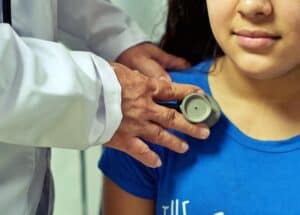Can my child go to school with croup? Well, the answer is simple but can best be answered after understanding what exactly croup is.
In simple words, croup is an infection of the upper airway that causes the larynx, trachea, and bronchi to swell. It’s also known as laryngotracheobronchitis, a word that is derived from affected parts. That is: the larynx, trachea, and bronchi, and itis which means inflammation is added at the end. Croup is a children’s disease. It is rare in both adults and young people above the age of six although the chances of an adult getting coup are almost zero.
Why can’t adults get croup? Being a disease that causes inflammation of the airway, it is difficult for an adult’s trachea to block. This is because an adult’s trachea is 15 mm in diameter on average while that of a child below the age of six is about 6 mm.
When the trachea wall swells, the proportion of airway that is left for adults is still enough while for children it’s significantly reduced hence getting much sicker compared to adults. As a child grows up, the chances of suffering from croup reduce due to an increase in the trachea size (diameter).
What is the Cause of Croup
Croup is caused by a virus hence it is a viral infection. The common virus associated with the disease is known as parainfluenza (para flue).
Other viruses connected with croup are:
- Respiratory syncytial virus
- Adenovirus
Children contracts croup by breathing infected respiratory droplets that have been sneezed or coughed into the air by an infected person, probably another child. They can also contract by touching infected surfaces and touching their eyes, mouth, and faces.

What Are the Symptoms of Croup
Croup’s symptoms last a week and in most cases within three days. These signs are mostly worse when it’s cold, when a child is crying, or in the evening.
Common symptoms are:
– Coughing which seals bark sound
– Noisy breathing (stridor) which comes from the inflamed airways
– Fever
– Running nose
How is Croup Diagnosed
Croup is diagnosed by a medical practitioner (doctor). In most cases, doctors observe and listen to a child’s chest for any symptom of croup. The throat is also examined as well as the child’s history of croup or related illness.
In its diagnosis, barking cough and stridor are the main clinical findings or aspects that croups are based on.
If your child shows any sign of croup, it’s important to seek medical attention. This is because the condition might get worse if action is not taken as soon as possible.
Get to Know the Best Sleeping Position for Coughing Baby
What Are the Treatments for Croup
Croup can be treated in two ways.
- Through home care where the infection clears up within three to six days.
- Through medications as prescribed by a doctor.
This is in case the situation has not worsened to the point of hospitalization which would require more centralized care.
To prevent its spread, children should be encouraged to regularly wash their hands. And in case they are infected, they should use a tissue when sneezing or coughing and dispose it properly.
What Are the Risks Associated With Croup
Although croup can be mild in nature, it can result in hospitalization. There are also several risks associated with it, some are rare. These are the consequences of not taking care of croup:
- Lymphadenitis
- Respiratory failure, especially if left untreated
- Middle ear inflation
- Lung collapse (partial)
- Breathing problems
Read on How to Stop Baby Walking on Tiptoes
Can My Child Go To School with Croup
It’s important to note that croup is contagious. In addition to being transmitted through sneezing and coughing, it can also be transmitted by coming into contact with contaminated surfaces such as chairs, toys, and door knobs and then touching your face, nose, or mouth.
Children love playing hence the rate at which they can infect each other with croup is high. The chances of them keeping themselves safe and ensuring that they regularly wash or disinfect their hands are minimal.
If your child has croup, it’s best not to go to school. This is because the condition will worsen since there is no one to keep an eye on them. When a child cries after being treated unfairly by other children, breathing will become more difficult. This is not good at all for a child with croup.
When your child stays at home, you will be in a position to take better care of them as well as practice some home remedies for croup such as providing humid air and offering fluids.
Not allowing your child to go to school is also for the benefit of the other children/students. This is because the chances of them getting croup are eliminated.

A comparison between the benefits and risks of sending your child to school while they have croup is important and in the end, the benefits outweigh the risks. Education is important for children but when children are unwell, their health becomes a priority. Missing school for 3 to 5 days is better than putting their health and the health of other children at risk.
Final Thoughts
In regards to taking a child with croup to school, there is no one-size-fits-all answer to this question. This is because the best course of action will depend on the individual child’s situation and health history. However, some tips that you should consider when making this decision are:
- Contacting the child’s pediatrician in order to get their medical history and to rule out any other health issues that could interfere with going to school;
- Ruling out any respiratory problems that your child is experiencing, such as croup, bronchiolitis, or pneumonia;
- Checking your child’s school’s policy on respiratory diseases;
- Consulting with a pediatrician or other health care professional about the best course of action for your child, based on their personal situation.







